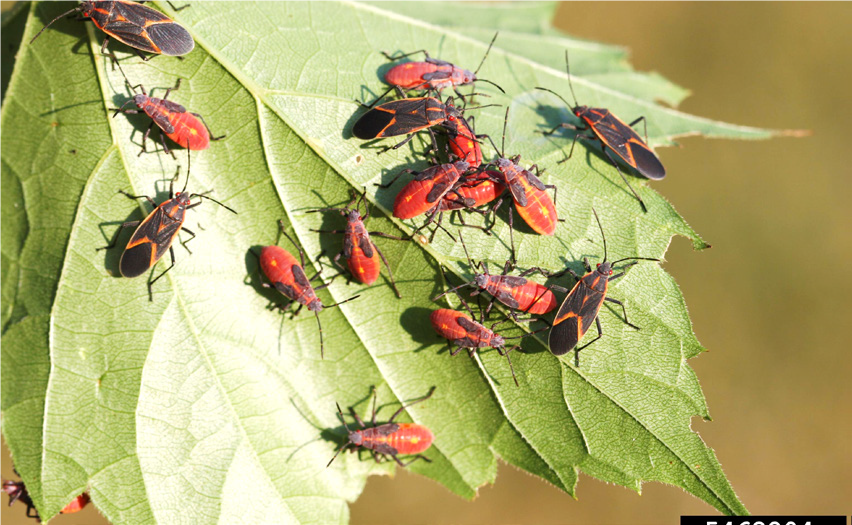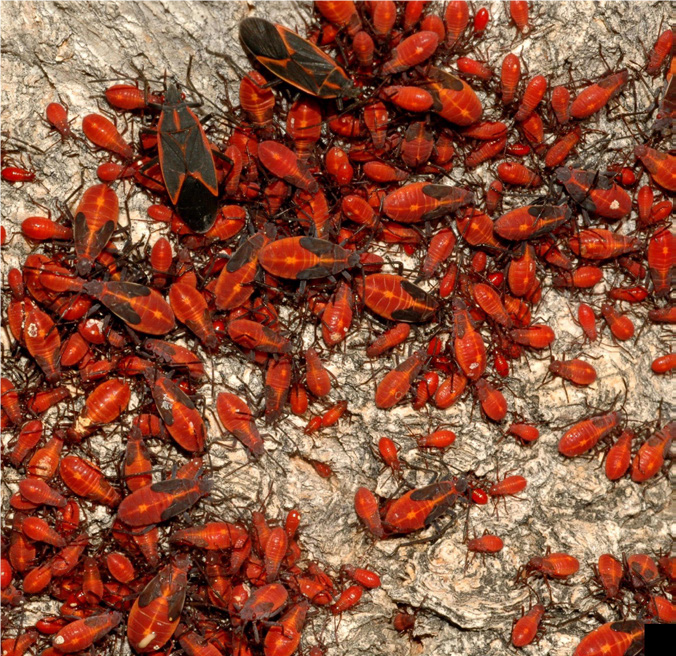The boxelder bug, Boisea trivittata, feeds primarily on pistillate (female) and seed bearing boxelder trees by sucking sap from leaves, tender twigs, and developing seeds. In heavily infested areas, the insect may attack ash and maple trees and the fruits of raspberry and strawberry plants.
The plant damage is not considered serious, but the insects themselves can be a nuisance to homeowners. In fall, the adults may congregate in large numbers in or on the outside of houses, seeking a place to hibernate.

Description
The adult bug is about 1/2" long. It is brownish-black with three longitudinal red stripes on its thorax and red margins on the basal half of its wings. Under its wings, the abdomen is bright red.
Life Cycle
Over-wintering adults leave their hibernation areas with the coming of warm spring weather. They then begin laying red eggs in crevices of boxelder bark and on the top of leaves and other objects. Eggs hatch in 11 to 14 days.
Nymphs are wingless (though they possess wing pads), darker towards their heads, and have red abdomens. They feed on leaves, fruits, and soft seeds by inserting their beaks into the tissues. They continue to feed throughout summer until they reach adulthood. Adults may emerge mid-summer, giving rise to a second generation that matures in the fall. The insect may become a problem at this time, accumulating in residential areas in search of favorable hibernation spots. These spots may include attics, cellars, and other protected area.

Service, Bugwood.org.
Management
IPM Strategies:
- Cultural Practices – (1) Prevent entry into a house by keeping vents, attic louvers, screens, etc., in good repair, and caulk and seal well before September 10th. (2) Eliminate hiding places such as piles of rocks, boards, leaves, and general debris close to houses. (3) Wash bugs off walls or tree trunks with a forceful stream of water. (4) Finally, to eliminate the bug problem completely, remove all pistillate (female) boxelder trees from a given residential area and replace them with either staminate (male) boxelder trees or with a tree species that has fewer insect problems.
- Chemical Control - Insecticide sprays are generally not recommended for boxelder bug management. However, for chemical control, consult your county Agricultural Field Specialist for specific pesticide recommendations.

Management International, Bugwood.org.

Stop! Read the label on every pesticide container each time before using the material. Pesticides must be applied only as directed on the label to be in compliance with the law. All pesticides listed in this publication are contingent upon continued registration. Contact the Division of Pesticide Control at (603) 271-3550 to check registration status. Dispose of empty containers safely, according to New Hampshire regulations.
Download the resource for the complete factsheet.
